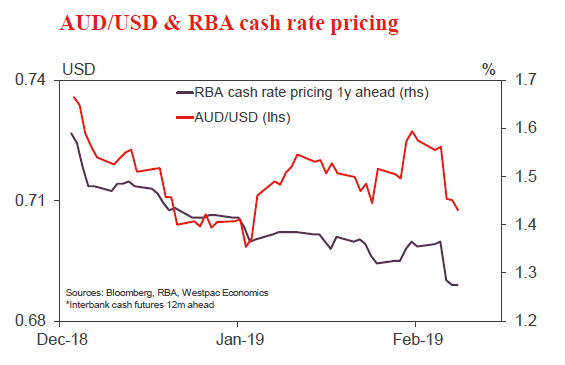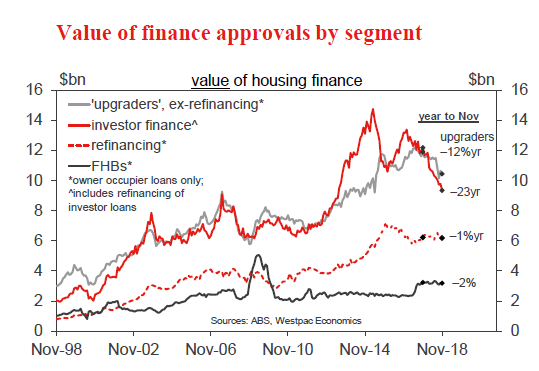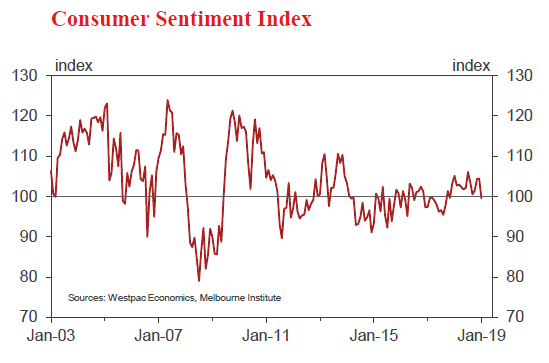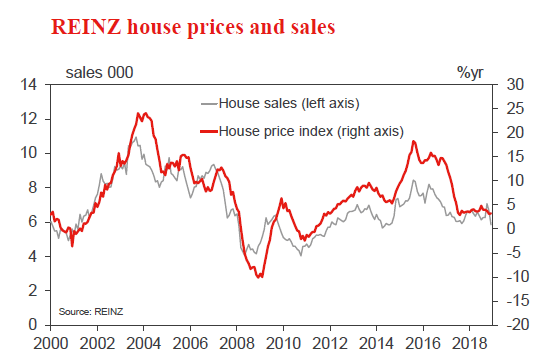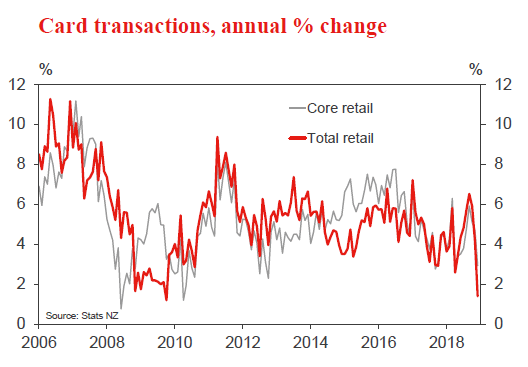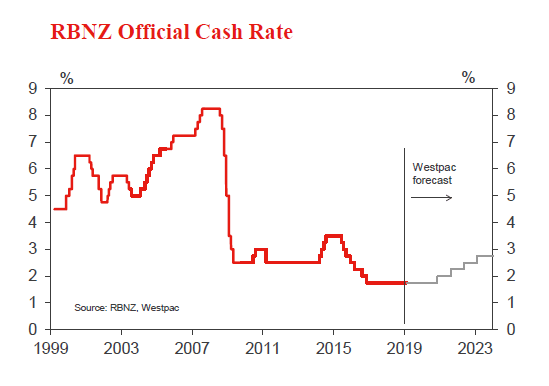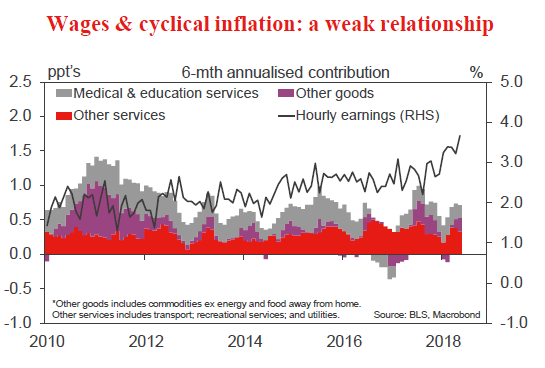Week beginning 11 February 2019
- RBA shifts to a more balanced view.
- RBA: Head of Economics and Assistant Governor Financial Markets speak.
- Australia: Westpac-MI Consumer Sentiment, housing finance, NAB business survey.
- NZ: RBNZ meeting, RBNZ Governor Orr testimony, card spending, house prices.
- China: trade balance, CPI, new loans, foreign direct investment.
- UK: GDP, CPI, retail sales.
- Europe: GDP 2nd estimate, trade balance.
- US: CPI, retail sales.
- Key economic & financial forecasts.
Information contained in this report current as at 8 February 2019.
RBA Shifts to a More Balanced View
The RBA has started the year with a significant shift, lowering its growth outlook and acknowledging greater uncertainties and downside risks. While the Board still expects the economy to track towards its employment and inflation targets, and does not see a strong case for a near term change in the cash rate, there has been a clear change in emphasis. In particular, the Governor has moved from the view, expressed throughout 2018, that “the next move in the cash rate was more likely to be an increase than a decrease” to one in which the probabilities of the next move being up or down are “more evenly balanced”.
This move to a balanced rate outlook is significant because it clearly establishes that the Bank is prepared to contemplate rate cuts – a position that has really only emerged since the housing markets have reversed. It is also consistent with changes announced by other central banks notably the US Federal Reserve. We see these changes as a welcome shift, bringing the RBA’s thinking more into line with our own.
As expected, the Reserve Bank Board again left the cash rate unchanged at 1.5% at its February meeting. Also as expected, the Bank has lowered its forecasts for growth – outlined in the Governor’s decision statement and detailed more fully in his speech a day later. The RBA’s growth forecast for 2019 has been revised down from 3¼% to 3%, and its forecast for 2020 revised from 3% to 2.75%, the slowdown year to year reflecting a tapering in resource export volumes. It is significant that growth on average is still expected to be around the ‘trend’ rate of 2¾%.
The RBA has also revised its inflation outlook with the forecast for underlying inflation for 2019 reduced from 2¼% to 2%, while the 2020 forecast remains at 2¼%. The Bank is maintaining the view that inflation will gradually move into the 2-3% band, although it is expected to take somewhat longer than previously expected.
There are good reasons why the Bank lowered its growth forecasts.
Firstly, while it still assesses the outlook for global growth as “reasonable”, it recognises that “downside risks have increased” (notably, when asked to rank the risks to the economic outlook, the Governor still nominates ‘global’ issues as a bigger concern).
Secondly, it has made some significant changes around the household sector and housing.
For some time, Westpac has argued that the fall in house prices in Sydney and Melbourne would be associated with a negative wealth effect weighing on consumer spending. In the RBA’s previous writings, it tended to dismiss this prospect. Although it is still downplayed, the Governor’s latest speech gives more weight to the issue, noting that rising housing prices provided an offset to slow income growth for some households and this effect is now shifting but that an expected pick-up in household disposable income was seen as providing a counterweight to the wealth effects of lower housing prices. Specifically, consumption growth is expected to lift over the forecast period to 2.75%, broadly in line with disposable income growth, implying a stabilisation in the savings rate. This ‘housing-consumer nexus’ is seen as a key area of uncertainty. It remains the key point of difference between Westpac’s 2.6%yr growth forecast for this year and next and the RBA’s at or above trend view.
Westpac has also argued that residential housing construction would be a drag on growth in both 2019 and 2020. The RBA did not support that view, referring to a strong pipeline and only a gradual decline. Recent falls in dwelling approvals, across both high rise and non high rise segments, are now pointing more clearly to a significant drag on growth from the housing construction downturn. Accordingly the RBA has downgraded its view, the Governor indicating dwelling investment is forecast to decline by about 10% over the next two and a half years.
The RBA continues to see rising business investment and higher levels of public infrastructure spending as the key growth drivers. It also remains positive about the labour market, reaffirming its forecasts for the unemployment rate to fall further to 4¾% by the end of 2020 and an associated lift in wages growth.
The Reserve Bank’s revised view has narrowed the gap with our own but Westpac remains more downbeat. Even so, our weaker forecasts have not been weak enough to warrant forecasting a rate cut. Accordingly, even if the RBA moves further towards Westpac’s current view it seems likely that rates will remain on hold.
The threshold for policy is whether spillovers knock the labour market off course. Our current forecasts do not incorporate that prospect but we acknowledge downside risks.
The week that was
It has been a week that the global economy arguably would like to forget, not because of financial market price action but rather owing to the policy and political tensions that have come to light.
Beginning in Australia, RBA Governor Lowe caught the market by surprise this week, shifting the Bank’s policy stance from a tightening bias to a balanced view. Backing this change, the RBA’s growth forecasts were revised down to 3.0% in 2019 and 2.75% in 2020, though the unemployment rate forecast was left unchanged at 4.75% for end-2020. On their own, these forecast changes would not be enough to warrant a neutral stance, but “the accumulation of downside risks” is clearly affecting the RBA’s view – as has been seen elsewhere around the globe.
Governor Lowe was clear in his speech that global risks, particularly China’s slowdown, remain their biggest concern. However, also increasingly front of mind are risks around the consumer, particularly the potential for a negative wealth effect for consumption and the scale of residential investment’s drag on growth. Having been optimistic on both fronts in 2018, now the RBA has revised down their forecast for consumption, and also sees a 10% decline in residential investment over the coming 2 ½ years.
The market has extrapolated the change in RBA tone and consequently fully priced in a cut by early-2020. However, as highlighted by our Chief Economist Bill Evans, the RBA’s forecasts have not yet come to our own more pessimistic view (growth of 2.6% in 2019 and 2020); and even if they did, outcomes such as these would not be weak enough to justify a rate cut.
Highlighting that downside risks to the above views may be growing however, this week’s data flow reported another sharp fall in dwelling approvals, to see them down 26% between September and December, as well as disappointing retail sales in the month of December and for the quarter overall. Notably, retail sales were particularly weak in NSW, where the largest house price declines have been seen, annual growth there slowing from 2.9%yr in mid-2018 to just 0.6%yr at December. Combined, these two releases point to downside risk for Q4 GDP and to soft momentum for the Australian economy as 2019 begins. Business and consumer sentiment measures will be closely watched for a response in coming months, so too the labour market detail.
Offshore, the data flow has been light, but headlines have kept the market busy. For Europe, the European Commission lowered its 2019 growth view from 1.9% to 1.3% (effectively trend growth and broadly in line with our 1.4% forecast), in part because they now see Italy growing by just 0.2% in 2019 after a recession in the second half of 2018. This pessimistic assessment has renewed concerns over the dispute between the Commission and Italy over their budget and debt position, with the Commission attributing Italy’s weakness to “uncertainty related to the government’s policy stance and rising financing costs”. Accordingly, government yields have moved sharply higher again. Further underscoring the divide between Europe and Italy, France has decided to recall their ambassador from Rome due to repeated “provocations” from Italy’s leaders.
News on Brexit this week was also grey, with UK Prime Minister Theresa May heading home from Brussels having failed to win further concessions from European officials. With the end- March deadline for a deal drawing ever closer, and the UK economy looking as though it is deteriorating by the month, uncertainty reins for the UK. On that matter, the Bank of England has cut its 2019 and 2020 growth view materially, and lowered the probability of tightening policy to 2020. We have long anticipated no move from the Bank in 2019 and 2020 as Brexit negotiations and the economy disappoint. This remains the case.
Finally, US/China trade tensions are again causing the market angst, with President Trump commenting that a meeting between he and President Xi is “unlikely” before the March 1 deadline (for a lift in the 10% tariff on $200bn of Chinese imports to the US to 25%). This followed White House Economic Advisor Larry Kudlow’s downbeat assessment of progress towards a deal, with “pretty sizable distance” remaining between the US and China. The risk of further disruption from US/ China trade tensions is material, and is likely to remain so through 2019.
Chart of the week: AUD and RBA pricing
The last few month’s have seen a dramatic shift in market sentiment towards the global and Australian economy. Market pricing has switched from pricing the likelihood of RBA hikes in early December, to now have a cut fully priced-in by early 2020. The crescendo picked up another notch this week with Governor Lowe’s speech marking a move to a neutral policy stance which saw the AUD immediately drop from 0.72 to 0.71 USD.
As per Chief Economist Bill Evans essay on the second page, Westpac retains its long-held view that the RBA cash rate will be on hold in 2019 and 2020.
Of course, market volatility has not been exclusive to Australia. To get a full overview of Westpac Economics’ outlook on interest rates, currencies and commodities, please see our February Market Outlook.
New Zealand: week ahead & data wrap
There and back again
A strong labour market has been a distinctive feature of the New Zealand economic landscape of late. However, as we suspected, the case was overstated in the September quarter. This week’s suite of labour market indicators were a little weaker than expected with the softness in hours worked pointing to a weak Q4 GDP outturn. Next week we expect the RBNZ to return to a more neutral policy stance when they release their February Monetary Policy Statement.
The sharp drop in New Zealand’s unemployment rate in the September quarter from 4.5% to 3.9% always looked ripe for a reversal. And indeed this is what we saw this week. Most of the surprise fall in September reversed out in the December quarter as the unemployment rate rose to 4.3% (from an upwardly revised 4%). While this doesn’t change the “big picture” view that the labour market gradually tightened over the last year, at the margin most recent developments have been weaker than we were anticipating as the pace of improvement in the labour market has slowed.
There was a pickup in wage inflation, but it was only gradual. The Labour Cost Index (LCI) rose by 0.5% in the March quarter for the quarter, with annual growth up slightly to 1.9%. That’s an improvement from the 1.6% pace that prevailed a few years ago, though some of that is due to government-directed pay increases such as the nurses’ pay settlement and the bigger minimum wage hike this year. The more volatile QES measure of average hourly earnings saw a more robust 1% rise, with annual growth ticking up slightly to 3.7%.
We expect wage inflation to feature more strongly over the coming years. Higher actual inflation, further hikes in the minimum wage and a more supportive political backdrop which shifts the dial a little further in the favour of employees rather than employers, should all help support a pickup in wage growth from here. However, this week’s data only took a small step in that direction.
Notably, employment growth across the suite of labour market measures was soft in the quarter. In the Household Labour Force Survey employment grew 0.1% in the quarter, and 2.3% in the year. That’s only slightly ahead of the 2.0% growth in the working age population. Cross checking with the QES, which surveys employers rather than households, confirms the softness. Filled jobs were up 0.3% in the December quarter and hours worked up just 0.1%.
Importantly, the weakness in hours worked measure increases the risk of a soft December quarter GDP result. The survey is a direct measure of activity in key service sectors. Our preliminary forecast for Q4 GDP growth was 0.8% but the QES outturn, combined with other recent activity indicators for Q4, implies this was too optimistic. The indictors we have on board to date suggest Q4 GDP growth was just 0.3%, in line with the rise in the previous quarter.
It is now abundantly clear that the economy lost momentum in late 2018. We suspect the key reasons were slowing net migration, the cooling housing market, a rapid rise in petrol prices and low business confidence resulting in slower business investment growth. We don’t expect this slower momentum to continue into the New Year. Fiscal policy is still set to provide a key support for growth in 2019 as the Government directly boosts incomes of households via its Families Package. The broader government spend-up on infrastructure and hiring is also set to continue, and petrol prices are predicted to be less of a drain on household budgets in 2019 than they were in 2018.
In addition, firm commodity prices and excellent growing conditions for some of New Zealand’s key commodity producers should support rural incomes this year. Dairy prices jumped almost 7% in this week’s GlobalDairyTrade auction. And while firm demand from China appeared to support the run-up in prices over January, hot and dry weather in New Zealand in recent weeks were the catalyst for the most recent price gains. If they’re sustained, our freshly minted $6.30 milk price forecast for the current season may well prove too conservative. Turning to next week’s RBNZ Monetary Policy Statement, we expect the RBNZ will leave the OCR firmly on hold, and shift to a more neutral policy outlook with language such as “the next move could be up or down”. We expect their OCR forecast will be flat for even longer, with the date of the first rate hike likely to be pushed back to mid-2021 (previously mid-2020).
Three key developments will be dominating the RBNZ’s deliberations. Firstly, the loss in momentum in the second half of 2018 has been greater than the RBNZ had been expecting. Secondly, the NZ dollar has been higher than they were projecting back in November as the Federal Reserve has cooled on the idea of lifting official interest rates. This strongerthan- expected NZ dollar dampens the outlook for tradables inflation. And finally, new net migration estimates from Stats NZ means the population is smaller and growing more slowly than previously thought. This may see the RBNZ lower its construction forecasts which in turn would dampen the outlook for GDP growth and inflation
Data Previews
Aus Dec housing finance (no.)
- Feb 12, Last: –0.9%, WBC f/c: –3.0%
- Mkt f/c: -2.0%, Range: -7.0% to -0.3%
Housing finance approvals softened in November with weakness concentrated in investor loans and the value, as opposed to the number of owner occupier loans. The headline number of owner occupier loans held up a little better than expected, recording a 0.9% decline. However, the total value of housing finance approvals including investors but excluding owner occupier refi, was down –2.9%mth and –16%yr.
The December update is expected to show a further weakening with industry data covering the major banks pointing to a sharp decline in the final month of the year. Owner occupier approvals are expected to show a 3% drop, adding to the bleak picture around housing in late 2018.
Aus Feb Westpac-MI Consumer Sentiment
- Feb 13 Last: 99.6
The Westpac Melbourne Institute Index fell 4.7% to 99.6 in Jan, dipping into pessimistic territory for the first time since late 2017. The ‘cautiously optimistic’ consumer mood that prevailed through last year evaporated at the start of 2019 with the usual holiday boost failing to materialise (note the headline index is adjusted for this regular boost, worth about 3-4pts). Confidence is coming under pressure from a continued slide in house prices; disappointing updates on Australia’s economic growth; ongoing concerns around global trade wars; and political uncertainty.
The Feb survey is in the field from Feb 4-9 and will be an important update given the Jan reading is clouded somewhat by holiday-related effects, and that the consumer remains the key focus of uncertainty and downside risks to the domestic outlook. The survey will capture reactions to the RBA’s shift to a less optimistic view on growth and ‘more balanced’ position on rates. Financial market influences look mixed this month with the AUD lower but ASX up 5.5% since Jan.
NZ Jan REINZ house sales and prices
- Feb 11 to 15 (tbc), sales last: -11.8%, prices last: 3.3%yr
The impact of the foreign buyer ban was evident in December’s housing market update. Sales fell sharply, with the drop concentrated in Auckland. There was also softness in Wellington and Christchurch. That pattern matches where foreign buyers have been most active.
Heading into 2019, we’ve seen signs that the housing market has caught a second wind. Sales for Auckland have picked up again. There’s also been an easing in lending restrictions, while mortgage rates have been pushing down from their already low levels.
Regional differences in price growth are likely to persist, with many areas outside of Auckland and Canterbury likely to see continued strong house price growth. Foreign buyers play almost no role in many regional centres, and the combination of lower mortgage rates and lending restrictions will give demand a further shot in the arm.
NZ Jan retail card spending
- Feb 12, Last: -2.3%, WBC : +1.4%
Retail spending fell by 2.3% in December – a much weaker result than had been expected. In part, that drop was due to falls in fuel prices. However, spending in core (ex-fuel) categories was also soft. That included a very sharp drop in spending on durable items, which posted their largest monthly decline since the financial crisis.
While there are questions about the strength of spending appetites, some of the recent weakness in durables could be related to measurement issues.
The recent volatility in durables means that there is greaterthan- usual uncertainty around this month’s outturn. We’re forecasting a 1.4% increase in retail spending in January. Underlying that is an assumed bounce in durables spending and moderate increases in other areas.
NZ RBNZ policy decision
- Feb 13, Last: 1.75%, Mkt: 1.75%, WBC: 1.75%
The RBNZ’s last statement was that the OCR would remain on hold through 2019 and into 2020, with gradual hikes forecast beyond that.
Recent data shows the New Zealand economy lost momentum in late-2018, and the exchange rate is higher than the RBNZ expected.
We expect the RBNZ to react by adopting a more dovish stance. The OCR forecast will likely feature later hikes, or even no hikes at all. The statement will reintroduce strictly neutral language along the lines of the next move being either up or down.
US Jan CPI
- Feb 13, last –0.1%, WBC 0.1%
Through late-2018, annual growth in the US CPI slowed abruptly, from 2.9%yr in July to 1.9%yr come December. This was the result of the sharp decline in energy prices, with core inflation (ex food and energy) instead unchanged over the period at 2.2%yr. Being above the 2.0%yr mediumterm target of the FOMC, and with the labour market unquestionably tight, inflation pressures could be seen as a clear and present risk.
To our mind however, this would be a mistake. In six-month annualised terms, core inflation has already decelerated to a 2.0% pace over the December quarter. And, looking ahead, the trends in its key components point to inflation remaining around the current level. Most interesting in this detail is the absence of a link between wages and inflation for cyclical goods.




